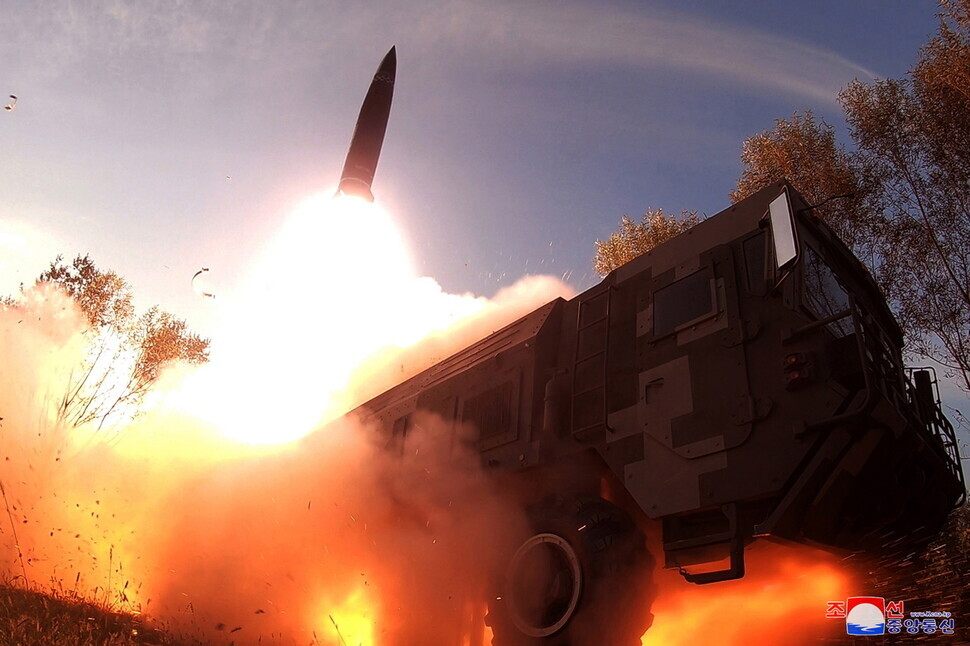hankyoreh
Links to other country sites 다른 나라 사이트 링크
N. Korea carries out 7 shows of nuclear capabilities over 2 weeks

North Korean news outlets’ major coverage of military drills for “tactical nuclear operation units” on Monday appeared meant to send the message that Pyongyang does not intend to back down in the face of joint military activities involving the South.
In particular, the North signaled that it has the nuclear capabilities to respond to drills by South Korea, the US and Japan near the Korean Peninsula amid the presence of the 103,000-ton USS Ronald Reagan aircraft carrier. By firing off different kinds of missiles, the North also showed that it has the means to deliver nuclear weapons regardless of weather conditions.
North Korea conducted seven launches between Sept. 25 and Oct. 9, firing a mixture of short-range ballistic missiles (SRBMs), intermediate-range ballistic missiles (IRBMs), and submarine-launched ballistic missiles (SLBMs). In terms of launch sites, the missiles were fired from various parts of North Korea, including Pyongyang and the provinces of North Pyongan, South Pyongan, Chagang, and Kangwon.
In a report Monday, the state-run Korean Central News Agency (KCNA) wrote, “Through seven times of launching drills of the tactical nuclear operation units, the actuality of the nuclear combat forces of our state and its militant effectiveness and actual war capabilities, which is fully ready to hit and wipe out the set objects at the intended places in the set time, were displayed to the full.”
It also said the military drills conducted over the recent two weeks targeted the US, South Korea and Japan.
With an SLBM launch from a reservoir near Taechon in North Pyongan Province on the morning of Sept. 25, the North explained that it had expanded its means and locations for launching nuclear weapons. In other words, it showed its ability to neutralize the US’ extended deterrence — a framework in which the US would launch a retaliatory nuclear strike if one of its non-nuclear allies were attacked with nuclear weapons.
By presenting a computer map showing the trajectory of an IRBM launched over the Japanese archipelago toward the Pacific Ocean on Oct. 4, the North showed that it is also capable of striking the US territory of Guam and US aircraft carriers and reinforcements approaching the Korean Peninsula in the event of an emergency. Pyongyang described the weapon as a “new-type intermediate-range ballistic missile.”
In South Korea’s case, the North emphasized that its missiles could be used to render key infrastructure useless.
In firing two SRBMs with dummy tactical nuclear warheads toward the East Sea from Pyongyang’s Sunan area on Sept. 28, the North showed that it can neutralize the South Korean Air Force airfields where US strategic bombers and stealth fighters would be arriving in the event of an emergency on the peninsula. On Saturday, it conducted drills with “super-large multiple rocket launchers” capable of striking main South Korean ports where US aircraft carriers and other reinforcements and war materials would arrive if conflict were to erupt on the peninsula.
The North further explained that its super-large multiple rocket launcher drills and SRBM missile launch on Thursday were strike exercises targeting the main military command facilities in the South. By “main military command facilities,” it was referring to the presidential office, Ministry of National Defense, and Joint Chiefs of Staff headquarters — all located in Seoul’s Yongsan neighborhood — and the Army, Navy, and Air Force headquarters at Gyeryongdae in South Chungcheong Province.
The KCNA made it clear that South Korea was the target of the ballistic missile and super-large multiple rocket launcher exercises over the two-week period, which it referred to as “launching drills of the tactical nuclear operation units” that were meant to “be a severe warning to the enemies.”
The North amplified the effect of its shows of force by mobilizing around 150 fighter aircraft on Saturday to conduct its largest-ever aerial attack drills.
By Kwon Hyuk-chul, staff reporter
Please direct questions or comments to [english@hani.co.kr]

Editorial・opinion
![[Guest essay] Preventing Korean Peninsula from becoming front line of new cold war [Guest essay] Preventing Korean Peninsula from becoming front line of new cold war](https://flexible.img.hani.co.kr/flexible/normal/500/300/imgdb/original/2024/0507/7217150679227807.jpg) [Guest essay] Preventing Korean Peninsula from becoming front line of new cold war
[Guest essay] Preventing Korean Peninsula from becoming front line of new cold war![[Column] The state is back — but is it in business? [Column] The state is back — but is it in business?](https://flexible.img.hani.co.kr/flexible/normal/500/300/imgdb/original/2024/0506/8217149564092725.jpg) [Column] The state is back — but is it in business?
[Column] The state is back — but is it in business?- [Column] Life on our Trisolaris
- [Editorial] Penalties for airing allegations against Korea’s first lady endanger free press
- [Editorial] Yoon must halt procurement of SM-3 interceptor missiles
- [Guest essay] Maybe Korea’s rapid population decline is an opportunity, not a crisis
- [Column] Can Yoon steer diplomacy with Russia, China back on track?
- [Column] Season 2 of special prosecutor probe may be coming to Korea soon
- [Column] Park Geun-hye déjà vu in Yoon Suk-yeol
- [Editorial] New weight of N. Korea’s nuclear threats makes dialogue all the more urgent
Most viewed articles
- 1[Column] Why Korea’s hard right is fated to lose
- 2Amid US-China clash, Korea must remember its failures in the 19th century, advises scholar
- 3[Column] The state is back — but is it in business?
- 460% of young Koreans see no need to have kids after marriage
- 5[Column] Life on our Trisolaris
- 6S. Korean first lady likely to face questioning by prosecutors over Dior handbag scandal
- 7Hybe-Ador dispute shines light on pervasive issues behind K-pop’s tidy facade
- 8Lee Jung-jae of “Squid Game” named on A100 list of most influential Asian Pacific leaders
- 9Yoon’s broken-compass diplomacy is steering Korea into serving US, Japanese interests
- 10[Reporter’s notebook] In Min’s world, she’s the artist — and NewJeans is her art